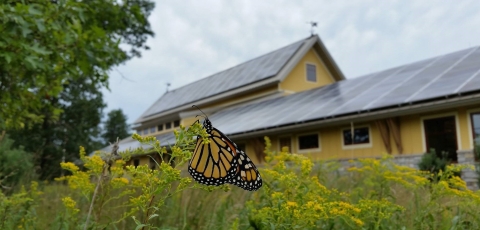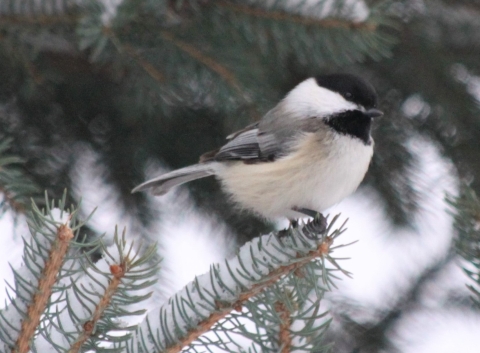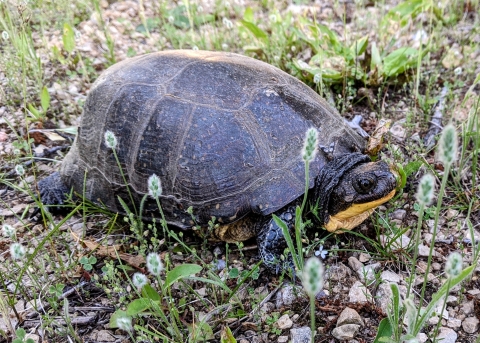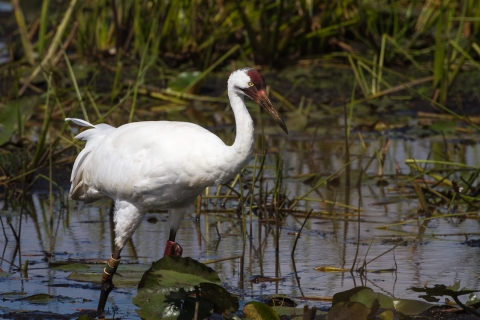Seasons of Wildlife
January through March
- Tracks give clues to types of wildlife in the area, when there where there and what they may have been doing
- Browse and scat also give away an animals presence
- Bear cubs are being born in dens
- Great horned and barred owls court and nest
- Bald eagles are preparing to nest
- Bobcats breed
March through May
- Mid-March waterfowl and cranes begin to return while ice still covers the wetlands during spring migration
- Frogs start emerge and join the chorus
- Owlets start branching
- Wolf pups are born
- Eaglets are born
- Whooping crane pairs defend territories and build nests
- Bears emerge with new cubs from dens
- Lupine begins to grow and Karner caterpillars hatch from over-wintered eggs
- Warblers arrive with May as the tree buds turn to leaves
- Lupines just start to bud as Karner blue butterflies emerge
June through August
- Fawns appear on the landscape
- Turkey poults start to fly at two weeks of age
- Bobcats are out of their den
- Warm season flowers and grasses start to bloom
- Bears bulk up on berries, nuts, seeds and insects
- Crane colts are flightless and forage with their parents
- The majority of the young of the year are out on the landscape
- Karner blue butterflies emerge for the second adult butterfly flight
- Fall migration starts as egrets appear on the refuge
September through November
- Bucks start to shed velvet from their antlers
- Black bears begin preparing a den site
- Small mammals are busy with preparing winter food storage
- Monarch super generation migrate to Mexico
- Salamanders migrate south
- Waterfowl migration peaks
- Fall color peaks in October
- Juncos return for the winter
- Turkey vultures migrate south
- Frogs and turtles slow down and prepare for hibernation
- The last few cranes, ducks and swans depart by mid-November
December
- Karner blue butterfly eggs wait dormant under grass and leaf litter
- Snowshoe rabbits are white
- Small mammals go through periods of torpor
- Plant seeds are triggered by cold temperatures to prepare for spring
- Fox actively hunt small rodents below the snow pack
- Chickadees can almost stop their heart rate to conserve energy in the coldest winter temperatures
Featured Species
Karner Blue Butterfly
Keep an eye on flowers during the months of late May to late July and into early August. You just might spy a Karner blue butterfly! This beautiful endangered species is only about the size of a quarter. Its pale blue markings of the male butterfly make it stand out among the purple lupine flowers that bloom in April. Necedah National Wildlife Refuge is home to the world’s largest population of this butterfly, thanks in part due to the abundance wild lupine plants that grow on the refuge. Karner caterpillars are entirely dependent on them. Check them out on the Lupine Loop Trail.
Meadow-beauty
At Necedah National Wildlife Refuge, you can view plants and birds with affinities to the tropics, Atlantic Coast, Rocky Mountains and tundra. One such plant is Meadow-beauty, also known as Rhexia. Rarely reaching two-feet-tall, Rhexia is a beautiful tropical plant with yellow anthers that are contrasted against vibrant, pink petals. How did a tropical plant end up in Wisconsin? It has been here since Wisconsin had more of a tropical climate. When you spot this plant, you are looking at an ancient relic of Wisconsin’s tropical past. This tropical plant that not only survived in Wisconsin’s current temperate climate, it also survived during periods when glaciers covered much of the state.
Blanding's Turtle
A reptile of many wetland types. Blanding's over winter on the refuge in the bottom of deep wetlands below the ice. Each spring the turtles move to shallower marshes, oxbows, wet prairies and sedge meadows near areas with soft, exposed sand for nesting. Hatchlings emerge from August to October using these shallow, slow moving water areas that connect to moist prairies and sedge meadows to forage before over wintering. The next spring the yearlings return to the surrounding areas where they were born and use this home range for almost 20 years before they nest for the first time.
Whooping Crane
As the principal federal partner responsible for administrating the Endangered Species Act, we take the lead in recovering and conserving our nation’s imperiled species, such as the whooping crane. As we work in partnership with others, our two major goals are to protect endangered and threatened species, and then pursue their recovery, and conserve candidate species and species-at-risk so that listing under the Endangered Species Act is not necessary. These spectacular birds are an enjoyable sight on the refuge.
Sedge Meadow
Thanks to a partnership with the University of Wisconsin-Milwaukee, the history of sedge meadows in Necedah National Wildlife Refuge was revealed during the summer of 2006. Peat soil cores more than six-feet deep were collected from sedge meadows and radio carbon dating showed that plant material on the bottom of the cores is more than 11,000 years old. These cores also revealed the plant communities of the area and found that sedge meadows on the refuge are most closely related to meadows in northern Wisconsin. These open wetlands are dominated by sedges and grasses and are important habitats for the bog-haunter dragonfly, golden-winged warbler, whooping crane and American bittern.
Tallgrass Prairie
The tallgrass prairie ecosystem, once one of our nation’s most diverse terrestrial ecosystems, has become functionally non-existent for the last 150 years. Loss and fragmentation of prairie landscapes combined with changes in natural processes have had negative consequences for many grassland plants and animals. The refuge is active in prairie restoration and it shows through the variety of prairie plants such as big and little blue stem grasses, blazing star, butterfly milkweed and goldenrods that serve as nesting and food sources for many species of insects and birds.




